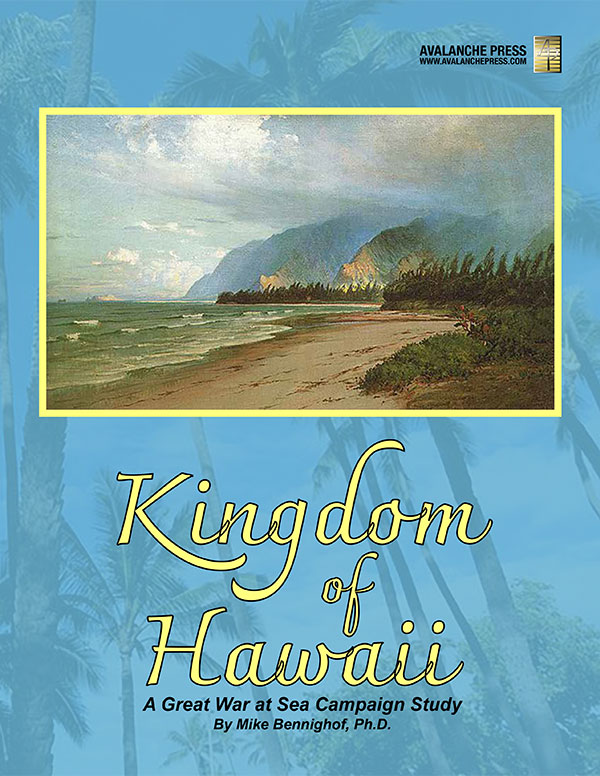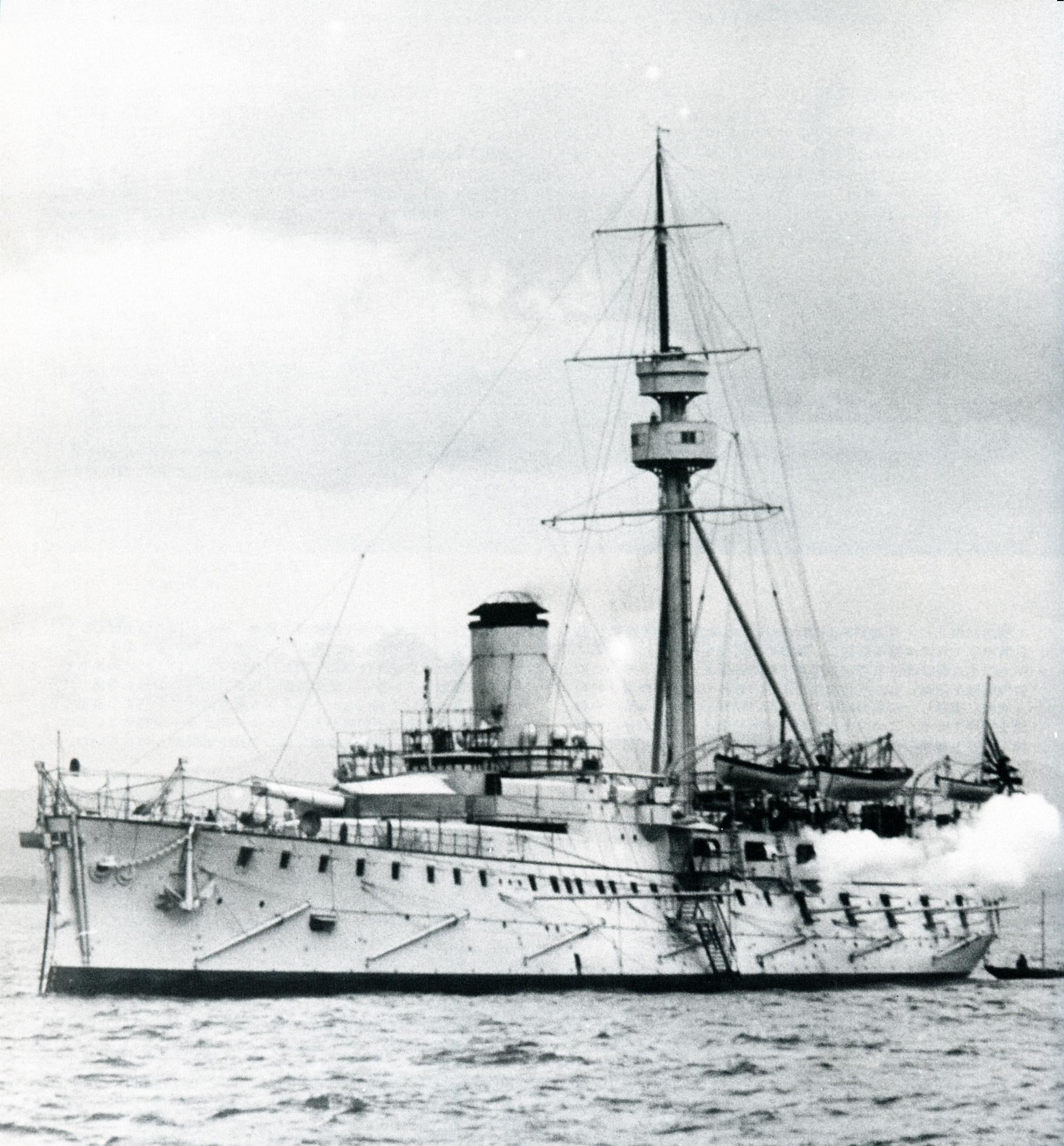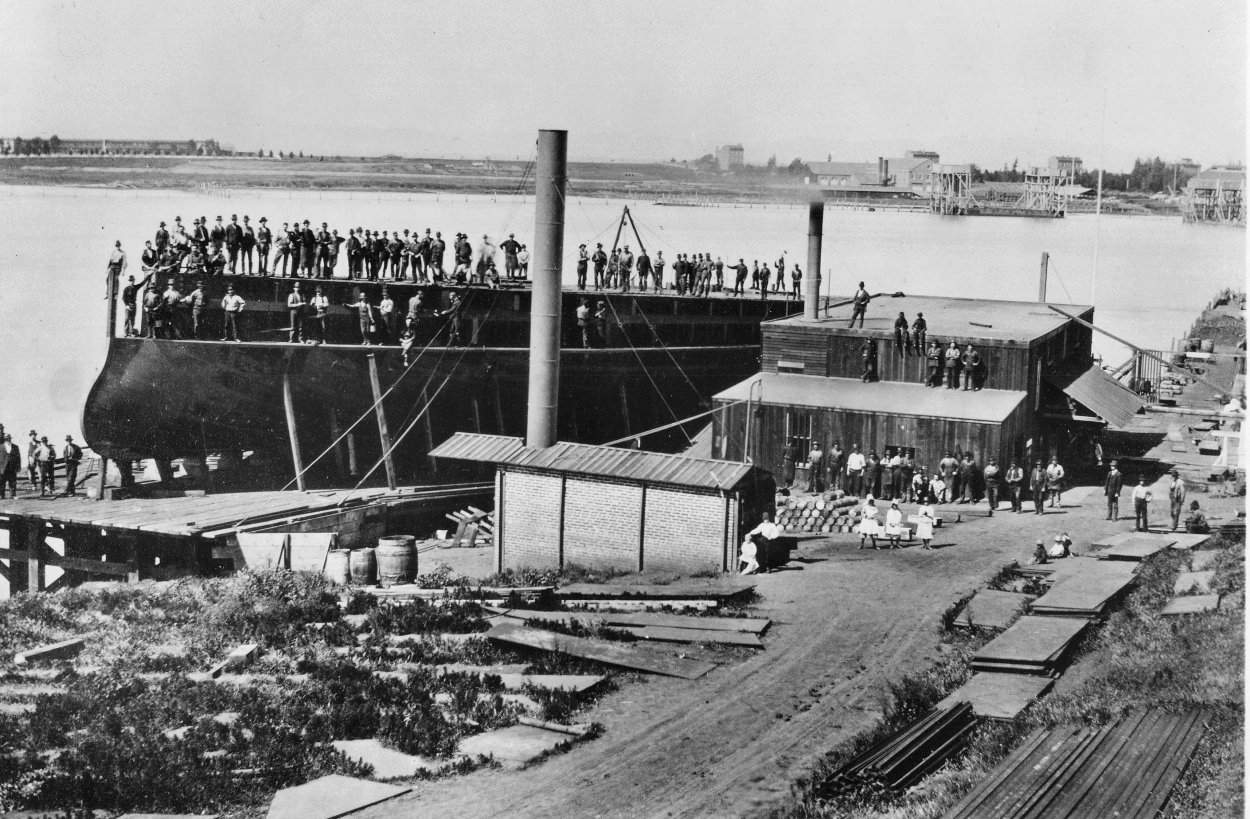| Kingdom of Hawaii
Fleets of 1893
by Mike Bennighof, Ph.D.
August 2024
 When the United States and Japan first confronted one another over the Hawaiian Islands in 1893, neither nation had as yet built the sort of fleet necessary to sustain their colonial ambitions. New ships were on their way, but only some had yet arrived. Both countries still depended on foreign sources of designs and some construction, with both rapidly expanding their domestic shipbuilding capacity. When the United States and Japan first confronted one another over the Hawaiian Islands in 1893, neither nation had as yet built the sort of fleet necessary to sustain their colonial ambitions. New ships were on their way, but only some had yet arrived. Both countries still depended on foreign sources of designs and some construction, with both rapidly expanding their domestic shipbuilding capacity.
Japan
The newly-resurgent Imperial government formed the Imperial Japanese Navy in 1869 to wage the Boshun War against the Republic of Ezo. The republic had been established on the northern island of Hokkaido by renegade supporters of the Tokugawa shogunate. The new imperial navy took over the ships belonging to the private fleets of several Japanese clans, but made a great leap in combat strength when it took over the French-built ironclad Kotetsu (“Iron-Covered Ship”), a ship purchased by the shogunate from the U.S. government, which had in turn seized her from the Confederate insurgent movement.
In its first years, the Navy remained subordinate to the Imperial Army, both bureaucratically and in terms of its coast-defense mission. That changed with arrival of a British naval mission in 1873, charged with organizing the Imperial Navy along British lines. That included a new Naval Academy, and the first purchase of purpose-built warships for the Imperial Navy (as opposed to those built for the clans or the shogunate), two armored corvettes and a broadside ironclad ordered from British shipyards.

Naniwa (left) and Boston, seen at Honolulu in 1893.
A series of incidents with the Chinese and Koreans brought home the need for a more powerful fleet in case of open conflict with either neighbor. In 1883 the government approved an eight-year plan to add 32 new warships, along with new taxes to pay for them; eventually bonds would have to be issued to cover revenue shortfalls and cost overruns.
The new program included many smaller vessels built in the new naval shipyard at Yokosuka, but the larger warships came from abroad. The first orders went to a British yard for a pair of protected cruisers, Naniwa and Takachiho. These ships displaced just 3,600 tons, but carried a pair of huge 10.3-inch slow-firing cannon in open barbette mounts fore and aft. British shipbuilders (in this case, Armstrong) touted ships like these as a lower-cost counter-weight to enemy battleships.
The two cruisers would see action in the 1894 Sino-Japanese War, and after re-arming with quick-firing guns, in the Russo-Japanese War of 1904-05. Naniwa would be shipwrecked in 1912, and Takachiho was sunk by a German torpedo boat during the 1914 Siege of Tsingtao. But these two ships would be the core of the Japanese forces that confronted the Americans over Hawaii in both 1893 and 1897.
A French yard received the order for a third cruiser, Unebi; she apparently was unstable as built and rolled over somewhere at sea between Singapore and Japan, disappearing with all hands.
Despite the Unebi disaster, the Imperial Navy turned to France for closer assistance in building its new fleet. In 1895 the French dispatched Louis-Émile Bertin, the 46-year-old director of naval construction at the Brest arsenal, already world-famous for his work on internal subdivision, armor application, and disease prevention at sea through proper ventilation. A brilliant man, holding double doctorates in law and engineering, he apparently was also always ready with a biting critique of other naval architects’ work and unpopular in some circles as a result. When the Emperor Mutsuhito asked for him by name, the French Navy’s Engineering Service (Genie Maritime) was happy to oblige.
Bertin may have been unpopular in France, but his Japanese students and associates loved him. Bertin brought his family along, and they all appear to have returned the love. He gave the building program a new direction, adjusting the fleet’s structure to Japan’s financial and industrial abilities. To the government’s great consternation, the rival Chinese ordered a pair of battleships in 1880 that now, after a protracted building time, finally neared completion. Japan had nothing to match them, nor could she afford to order battleships of her own.

Cruiser Itsukushima and her gigantic cannon seen at Kobe
in 1897.
Their French mentor had an answer. Bertin designed a cruiser of 4,200 tons, about half the size of the Chinese battleships, armed with a single gigantic 12.6-inch (320mm) gun plus a dozen 4.7-inch quick-firing guns. The main weapon would be mounted forward on two of the three cruisers ordered to his plan, and aft on the third. The French-made cannon greatly out-ranged the 305mm (12-inch) Krupp short-barreled guns of the Chinese battleships, and at least on paper these guns could penetrate the Chinese ships’ armor while remaining outside the range of the Chinese guns. Two of the ships were built in France, and one in Japan.
Those paper qualities did not hold up in practice; the three cruisers managed 13 shots between them at the Battle of the Yalu against the Chinese in 1894, an average of one shot per hour rather than the two per minute promised by the manufacturer, Canet. They scored no hits.
Bertin also designed Japan’s first armored cruiser, the 2,400-ton Chiyoda, which he initially hoped to arm with two of the 12.6-inch battleship-killers. Those proved too heavy, and she carried ten 4.7-inch quick-firing guns instead. He also designed three small unprotected cruisers, one built in France and two in Japan.
When not drafting new ships, or entertaining Mutsuhito and the Empress Haruko, who seem to have taken a liking to the Frenchman, Bertin also re-designed the Yokosuka Arsenal and oversaw the openings of new naval arsenals at Sasebo and Kure. When he returned to France in 1890, he left behind the core of the fleet that defeated the Chinese in the 1894 Sino-Japanese War, and would have faced the Americans in an 1893 confrontation over Hawaii.
Daily Content includes no AI-generated content or third-party ads. We work hard to keep it that way, and that’s a lot of work. You can help us keep things that way with your gift through this link right here.
The United States
At almost the same time that Japan began building the Imperial Navy, the United States took the first step toward replacing the Civil War-era wooden frigates and ironclad coast-defense monitors with modern steel warships. Secretary of the Navy William Hunt convened a board that recommended building 31 new ships, a proposal doomed to Congressional defeat. Hunt’s successor, William Chandler, made a more reasonable proposal for two ships, which Congress kindly doubled to four when the measure finally passed in March 1883.
The measure also included completion of five monitors begun in 1874 as supposed “repairs” of decrepit Civil War vessels, but actually new ships bearing the same names. These had been contracted with private yards, including one that had never built a ship before (and never would again) and paid for in large part with scrap iron from other ancient monitors. The rusting hulks were now dragged to naval shipyards for “completion,” which in several cases meant starting over. After re-design, the first did not enter service until 1891, and the other four in 1895 and 1896. These ships had been useless in 1874, and if possible were even less capable when completed 22 years later.

Monitor Monadnock prior to launch at Burgess shipyard, September 1883. Hard to believe that Burgess had never built a ship before (and never would again).
The four new steel ships were not that much better. All four of them, three protected cruisers and a dispatch vessel (in the days before radio, messages had to be carried by small, fast ships built for the purpose) were ordered from John Roach’s Philadelphia shipyard. Roach had been a favored contractor for the monitor project, as he owned a steel mill alongside his shipyard and was willing to take old ironclads as payment. His was the only yard to win two monitor contracts. When these were cancelled, the steel ships appear to have been awarded to Roach in compensation.
The dispatch vessel, Dolphin, had been designed with a full sail rig and a heavy armament for her size, both of which made her unstable and the Navy refused to accept her without a re-design. The ship had to be re-designed without the sails and with lighter guns, and the Navy would not pay until the work had been completed. That bankrupted Roach, then the largest shipbuilder in the United States, and the two of the remaining ships moved to a naval shipyard for completion.
The sister ships Atlanta and Boston, completed at New York Navy Yard, carried a pair of 8-inch guns in open barbettes, and six 6-inch guns. Although their design was attributed to Assistant Naval Constructor Francis T. Bowles, they were actually designed by a committee of bureaucrats and politicians, with predictable results. They guns were too large and too numerous for their size, and were slow-firing types even as the quick-firing gun was becoming the standard in the Royal Navy. And as the first large ships built by the navy yard, they showed numerous structural defects.
The third cruiser, Chicago, was somehow even worse. She was larger than Atlanta and Boston, but likewise over-armed with four 8-inch and six 6-inch slow-firing guns. She lay incomplete at Roach’s shipyard for three years while the company re-organized, finally completing there as an utterly obsolete vessel in 1889. Her captain, the theorist Alfred Thayer Mahan, found her sorely wanting and in 1895 she went to the New York Navy Yard for re-construction, missing out on the Spanish-American War.

Cruiser Atlanta, seen in 1891. Gunboat Yorktown in background.
Learning from this disastrous initial program, the Navy ordered three more cruisers in 1887, this time only after purchasing plans from British shipyards. These three ships – Baltimore (a near-copy of the Japanese Naniwa), Charleston and Newark – turned out much better, though still not up to the world standard. Four small cruisers, actually over-armed gunboats, rounded out the program. One modified repeat each of Baltimore and Newark, named Philadelphia and San Francisco respectively, followed in 1889.
The Navy also ordered a pair of armored ships in 1886, that became the armored cruisers (later battleships) Texas and Maine, following up in 1889 with the armored cruiser New York. Texas and Maine turned out to be very poor designs; New York, on the other hand, finally gave the Navy a modern major warship.
That formed the U.S. Navy of 1893, when the first confrontation arose with Japan. None of the armored ships were yet ready for action; extended building times continued to plague American naval construction. The modern cruisers gave good service showing the flag around the globe, but as fighting ships were no better than those of the Japanese.
You can order Kingdom of Hawaii right here.
Pineapple Empire
Remember the Maine
Russo-Japanese War
Kingdom of Hawaii
Retail Price: $142.97
Package Price: $120
Gold Club Price: $96
You can experience the Pineapple Empire Package right here.
Sign up for our newsletter right here. Your info will never be sold or transferred; we'll just use it to update you on new games and new offers.
Mike Bennighof is president of Avalanche Press and holds a doctorate in history from Emory University. A Fulbright Scholar and NASA Journalist in Space finalist, he has published a great many books, games and articles on historical subjects; people are saying that some of them are actually good.
He lives in Birmingham, Alabama with his wife, three children, and new puppy. He misses his lizard-hunting Iron Dog, Leopold.
Daily Content includes no AI-generated content or third-party ads. We work hard to keep it that way, and that’s a lot of work. You can help us keep things that way with your gift through this link right here.
|
